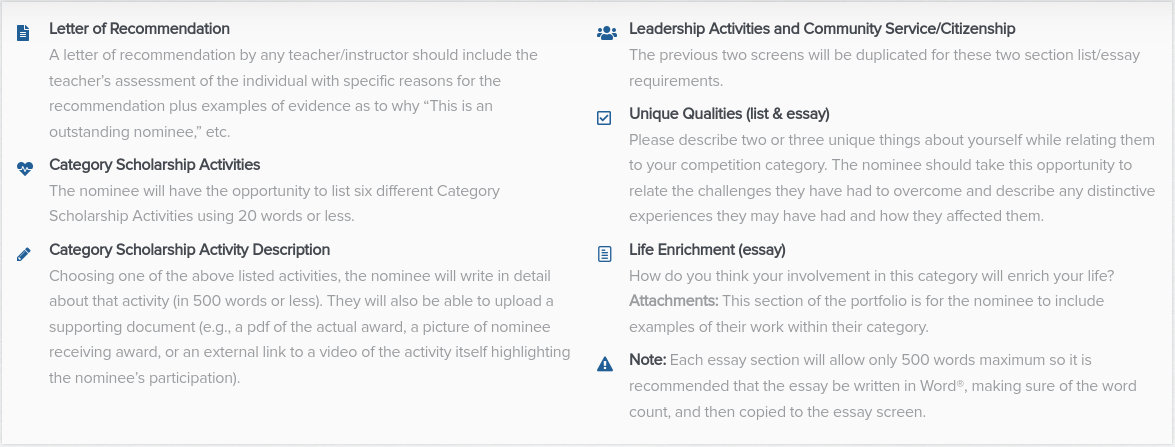Starting as early as 1960, the acknowledgement for educational excellence has been in full pursuit. As Deseret News states, “If student athletes receive acclaim, why not high school scholars?” and this statement was taken to heart. 53 years later, the program titled “Sterling Scholar” continues to stand as a program of recognition in academic merit.
What is Sterling Scholar, anyway? Generally speaking, Sterling Scholar is a competition in which its participants are judged in category scholarship, leadership, community service/citizenship, and their interview. However! The website does note that due to the broadness of these areas, that it is “very unlikely that each Sterling Scholar nominee will have experience in all areas listed”, as an acknowledgement of student diversity and potential struggle. In Utah, every high school can choose up to 14 nominees for the following categories to compete in: English, speech / theater arts / forensics, mathematics, social science, science, world languages, visual arts, computer and information technology, trade and technical education, agriculture science, family and consumer science, business and marketing, music (the website states that “vocal and instrumental talents are considered equal”), and dance. While it is not required they nominate a student for every category, most highschools do. Additionally, students may apply for more than one category, but they will be selected for only one of them, should they qualify.
So what makes Sterling Scholar so prestigious? Well, not only are there only 14 applicants chosen from each high school (In Utah, the average size of a high school student body is 900-1100, according to the Public School Review, meaning that only 1.2% of a student body are nominated as Sterling Scholar), but there are then 14 selected contestants from each of the 5 regions, who go on to compete on a state level for the final round.
Don’t let that chase you away, though. While it’s a lot of work for something that most people don’t really think about til senior year, judges are specifically instructed to review students “with reason, prudence and wisdom”. They cannot disclose scores, and names are not ranked by score either, but by alphabetical order, to ensure a fair, reliable, and kinder process.
OHS alumni Sophia Smith (Who won the English Sterling Scholarship on a school level last year) said that she would recommend it for “not just academically gifted students, but for every student if you are interested and you meet the requirements”. She did clarify as well though, that “It’s a tight competition and commitment that isn’t for everyone”.

More than just a tremendous accomplishment, Sterling Scholar is a thorough and intense application process. The applicants are expected to attach a portfolio containing essays in response to 4 essay prompts, and none of the essays can be longer than 500 words on their own, with three additional documents that are as follows: A letter of recommendation, a document displaying “Category Scholarship Activities”, and another document displaying a student’s contribution to their community through service and leadership. Both of these have a follow-up essay. For those competing in any of the performing arts categories, they must prepare an audition piece.
And as a general, across-the-board expectation, everyone is advised to prepare themselves for the interview- which is about 10 minutes in length. As contestants move onto the next round, more interviews will be conducted, and their lengths vary. Interviews are vital, especially for those moving onto other rounds. After all, many people have academic rigor– but what makes all the difference will be the skills conducted in conversation with the judges. That being said, the website does have sample questions for aspiring scholars to practice so that they can do their very best in their individual interviews.
So what’s in it for you, the student? On a school level, Smith said that it “was worth it” as it helped her “get scholarships and to get into colleges” as well as being useful for additional resumes. The scholarship money won however, is purely on a regional level and it varies depending on the college. Every college does award at least 1k, should you attend their school. BYU, a commonly sought after college for many, specifically awards two full semesters of free tuition to their school for final round regional winners.
Again, these scholarships are specific to regional qualifications, and still vary. Smith had also commented that there weren’t really “a ton of school benefits from winning sterling scholar” aside from the fact that there was a photo of her in the halls for “half the school year”. So while there were certainly “bragging rights”, such as sitting up with the administration and student council at graduation(Sterling Scholars are also among the last students to be announced, as an honorary notion), on a school level the title doesn’t necessarily hold much of an impact.
It’s understandable that Sterling Scholar isn’t every student’s ideal, or even a possibility and/or desire for some. However, for those who are willing to put in the extra effort to receive recognition for academic merit (and to hopefully win some scholarships), Smith said that one can expect a “pretty rigorous” process that will absolutely pay off in the long run, if you want it to.
Alexandria Rhinehart
Latest posts by Alexandria Rhinehart (see all)
- Sterling Scholar – What do YOU need to know? - October 18, 2023
- Orem City Marching Band: The Path to State Champions - March 10, 2023








